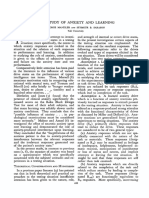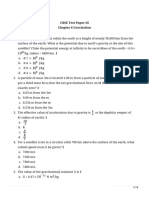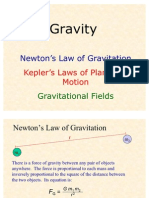0 ratings0% found this document useful (0 votes)
100 viewsLecture
This document discusses Newton's law of universal gravitation and its applications. It defines that the gravitational force between two masses is directly proportional to the product of their masses and inversely proportional to the square of the distance between them. It then provides examples of how this law can be used to calculate gravitational forces and gravitational potential energy. It also discusses how gravitational forces allow satellites and planets to maintain elliptical orbits according to Kepler's laws of planetary motion.
Uploaded by
Kenn SenadosCopyright
© © All Rights Reserved
Available Formats
Download as PPTX, PDF, TXT or read online on Scribd
0 ratings0% found this document useful (0 votes)
100 viewsLecture
This document discusses Newton's law of universal gravitation and its applications. It defines that the gravitational force between two masses is directly proportional to the product of their masses and inversely proportional to the square of the distance between them. It then provides examples of how this law can be used to calculate gravitational forces and gravitational potential energy. It also discusses how gravitational forces allow satellites and planets to maintain elliptical orbits according to Kepler's laws of planetary motion.
Uploaded by
Kenn SenadosCopyright
© © All Rights Reserved
Available Formats
Download as PPTX, PDF, TXT or read online on Scribd
You are on page 1/ 23
1.
Newtons Law of Gravitation
2.Weight
3.Gravitational Potential Energy
4.The motion of the Satellites
5.The motion of Planets
1. Electromagnetic Forces
2. Strong Force
3. Weak Force
4. Gravitational Force
earliest of the four to be studied
extensively
the same interaction that makes an
apple fall out of a tree and keeps the
planet in their orbits around the sun
Every particle or matter in the universe attracts every other
particle with a force that is directly proportional to the
square of the distance between them.
In mathematical form:
Where
is the vector force on mass
m
1
exerted by mass m
2
r
21
is the distance between m
1
and m
2
is a unit vector that points
from mass m
2
toward
mass m
1
along the line
joining them
G = 6.67x10
-11
N . m
2
/ kg
2
is the
universal gravitational constant
m
1
m
2
r
21
r
21
By Newtons third law, the force F
21
acting on m
1
must have the
same magnitude as F
12
but acts in different direction so
If there are many masses, the total gravitational force on a given
mass, say m
1
Where F
1i
means the force on mass 1 exerted by mass i.
Ex.1. The mass m1 of one of the small spheres of a Cavendish
balance is 0.0100 kg, the mass m2 of one of the are spheres is 0.500
kg, and the center-to-center distance between them0.0500 m. Find
the Fg on each sphere due to the nearest other sphere.
Fg = (6.67x 10
-11
N . m
2
/kg
2
)(0.0100 kg)(0.500kg)
(0.0500m)
2
This is a very small force. We dont experience noticeable
gravitational pulls from ordinary low-mass objects in our
environment. It takes a truly massive object such as the earth to
exert substantial gravitational force.
The weight of the body is defined as the total gravitational force
exerted on the body by all other bodies in the universe.
If we model the earth as a spherical symmetric body with radius R
E
and mass m
E
, the weight w of a small body of mass m at the earths
surface is
(9-4)
But by Newtons 2
nd
law, w=mg (9-5)
The equation shows that acceleration due to gravity is independent of
the mass of the body
Note that P.E. U=mgy where we consider g as constant.
But, gravitational force exerted on a body of mass m at
any point outside the earths surface is given by Eq. (9-4).
If distance r changes, we need a more general expression
for GPE.
The radial force F
r
exerted by the earth on any mass m at a distance
r from the center of the earth towards the center of the earth has
the expression
Then, the work done by the gravitational force when the body
moves directly away from or towards the center of the earth from
r =r
1
to r=r
2
is
The previous equation shows that the work W
grav
depends only on
the initial and final values of r. Thus gravitational force is
conservative.
W
grav
= U
1
U
2
. Thus, the gravitational potential energy is
Satellites can be put into orbit by accelerating it to a sufficiently
high tangential speed with the use of rockets.
At certain speed, the satellite can be put into orbit.
When a satellite moves in circular orbit, the centripetal acceleration
is provided by the attraction of the earth. The speed v and the
period T of a satellite in a circular orbit with radius r are
Suppose you want to place a 1000-kg weather satellite into a circular
orbit 300 km above the earths surface. (a) What speed and period
must it have? The earths radius is 6380 km and its mass is 5.97 x
10
24
.
(a) The radius of he satellites orbit is
r = 6380 km + 300 km = 6680 km = 6.68 x 10
6
m
= = 7720 m/s
T = 2r/v = 2(6.68x10
6
m)/7720m/s
= 5440 s =90.6 min
The motion of the planets are described accurately by Keplers
laws of planetary motion. These laws where based on the data
collected by Tycho Brahe.
Keplers three laws are:
1. Each planet follows an elliptical path with the sun at one
focus.
2. A line from the sun to a given planet sweeps out equal areas
in equal time interval.
3. The periods of the planets are proportional to the 3/2
powers of the semimajor axis of its elliptical path.
The distance from perihelion to
aphelion (2a) is called major axis
The half-distance, a, is called
semi-major axis.
The distance of each focus is ea
where e is the eccentricity with
values between 0 and 1. if e = 0
the ellipse is a circe.
NOTE:
The sum of the distances SPS
and SPS is the same for all points
on the curve where S and S are
the foci.
(a) The planet P moves about the sun S in an elliptical orbit.
(b) In time dt the line from the sun to the planet sweeps out a
triangular area dA = r(rd) = r
2
d.
(c) The planets velocity
varies so that the ratio of
area dA to time interval dt is
constant, regardless of the
planets position in its orbit.
A planet moves faster when it is closer to the sun than when it
is farther away.
Remark: Keplers 1
st
and 2
nd
law are valid only for 1/r
2
force.
The period of a satellite or a planet in an elliptical orbit is
proportional to the 3/2 power of the semi-major axis a:
T = Ca
3/2
where C is a constant having the same value for all planets
Newton also showed that Keplers third law is also true for elliptical
orbits, he replaced the orbit radius r by the semi-major axis a:
Where m
s
is the suns mass. m
e
is replaced by m
s
because the
planets orbit the sun not the other way around!
You might also like
- Clare Gibson - The Complete Book of Birthdays - Personality Predictions For Every Day of The Year (2016, Wellfleet Press) PDF72% (67)Clare Gibson - The Complete Book of Birthdays - Personality Predictions For Every Day of The Year (2016, Wellfleet Press) PDF419 pages
- Planets in Transit - Life Cycles For Living98% (41)Planets in Transit - Life Cycles For Living540 pages
- Jason Miller - Advanced Planetary Magic PDF61% (44)Jason Miller - Advanced Planetary Magic PDF64 pages
- Space Vampire - Choose Your Own Adventure 71100% (4)Space Vampire - Choose Your Own Adventure 7167 pages
- Astrological Transits - The Beginner's Guide To Using Planetary Cycles To Plan and Predict Your Day, Week, Year (Or Destiny)90% (31)Astrological Transits - The Beginner's Guide To Using Planetary Cycles To Plan and Predict Your Day, Week, Year (Or Destiny)317 pages
- Zodiac Decans: The Modern Astrological Decans & Natal Charts88% (8)Zodiac Decans: The Modern Astrological Decans & Natal Charts15 pages
- Astrological Relationship Handbook - Kevin B. Burk (2006, Serendipity Press)97% (31)Astrological Relationship Handbook - Kevin B. Burk (2006, Serendipity Press)282 pages
- Data and Analytics Scenarios Assignment - SenadosKMNo ratings yetData and Analytics Scenarios Assignment - SenadosKM4 pages
- PDF Jason Miller Advanced Planetary Magicpdf DL100% (4)PDF Jason Miller Advanced Planetary Magicpdf DL64 pages
- Ring Makers of Saturn - Norman Bergrun 1986100% (10)Ring Makers of Saturn - Norman Bergrun 1986125 pages
- Gravitation_Elasticity_of_solids_slidesNo ratings yetGravitation_Elasticity_of_solids_slides87 pages
- Newton's Law of Universal Gravitation (Physics)100% (2)Newton's Law of Universal Gravitation (Physics)43 pages
- Sph 201 Mechanics II Lect Three GravitationNo ratings yetSph 201 Mechanics II Lect Three Gravitation24 pages
- Artificial Satellites: Sunil Kumar SinghNo ratings yetArtificial Satellites: Sunil Kumar Singh8 pages
- The Laws and Velocity of Planetary Motion: Section - 10 FNo ratings yetThe Laws and Velocity of Planetary Motion: Section - 10 F3 pages
- Paramahamsa Tewari - On Planetary Motion Caused by Solar Space VortexNo ratings yetParamahamsa Tewari - On Planetary Motion Caused by Solar Space Vortex9 pages
- Unified Field Theory in a Nutshell1: The Quest for the Theory of EverythingFrom EverandUnified Field Theory in a Nutshell1: The Quest for the Theory of EverythingNo ratings yet
- University of Science and Technology of Southern PhilippinesNo ratings yetUniversity of Science and Technology of Southern Philippines1 page
- Examining The Factors of Licensure Examination For Teachers Performance For Program Strategy EnhancementNo ratings yetExamining The Factors of Licensure Examination For Teachers Performance For Program Strategy Enhancement7 pages
- Coulomb's Law and Electric Field Intensity: Engineering ElectromagneticsNo ratings yetCoulomb's Law and Electric Field Intensity: Engineering Electromagnetics24 pages
- University of Science and Technology: Official List of Enrolled StudentsNo ratings yetUniversity of Science and Technology: Official List of Enrolled Students1 page
- Answers To Even Problems: 714 Ma 1.29 A 12.6 VNo ratings yetAnswers To Even Problems: 714 Ma 1.29 A 12.6 V2 pages
- Identical Particles: MSU-Iligan Institute of TechnologyNo ratings yetIdentical Particles: MSU-Iligan Institute of Technology7 pages
- Lecture Topics Polymer Science and Technology Lab: Advanced Experimental Design (1 Aug - 15 Oct 2014, Msu-Iit) Arnold Lubguban, PHDNo ratings yetLecture Topics Polymer Science and Technology Lab: Advanced Experimental Design (1 Aug - 15 Oct 2014, Msu-Iit) Arnold Lubguban, PHD2 pages
- (SEC Reg. No. CN200427840) C/o Department of Physics, MSU-Iligan Institute of Technology 9200 Iligan City, Philippines and Host UniversityNo ratings yet(SEC Reg. No. CN200427840) C/o Department of Physics, MSU-Iligan Institute of Technology 9200 Iligan City, Philippines and Host University1 page
- Complementary C. and Everything. Unitary Operators Download Tanoudji Vol2No ratings yetComplementary C. and Everything. Unitary Operators Download Tanoudji Vol21 page
- Finite Potential Well and Potential Steps: Clear Deviations From Results of Classical PhysicsNo ratings yetFinite Potential Well and Potential Steps: Clear Deviations From Results of Classical Physics46 pages
- Phys 198 Methods of Research: BRB Sambo - NMT PaylagaNo ratings yetPhys 198 Methods of Research: BRB Sambo - NMT Paylaga22 pages
- Andromeda: The Chained Woman: Joshua Wihongi Physics 1040 Sp17 Constellation PaperNo ratings yetAndromeda: The Chained Woman: Joshua Wihongi Physics 1040 Sp17 Constellation Paper11 pages
- Reading Your Birth Chart (2015) - GoldRing Astrology100% (6)Reading Your Birth Chart (2015) - GoldRing Astrology6 pages
- This Fascinating Astronomy Science For Everyone100% (3)This Fascinating Astronomy Science For Everyone304 pages
- (1906) Wireless Telegraphy and Telephony (Wireless Radio)100% (1)(1906) Wireless Telegraphy and Telephony (Wireless Radio)436 pages
- Third Semester B.E. (CBCS) Examination Engineering Mathematics-IIINo ratings yetThird Semester B.E. (CBCS) Examination Engineering Mathematics-III3 pages
- Earth Resistivity Measurement Interpretation TechniquesNo ratings yetEarth Resistivity Measurement Interpretation Techniques9 pages
- Clare Gibson - The Complete Book of Birthdays - Personality Predictions For Every Day of The Year (2016, Wellfleet Press) PDFClare Gibson - The Complete Book of Birthdays - Personality Predictions For Every Day of The Year (2016, Wellfleet Press) PDF
- Astrological Transits - The Beginner's Guide To Using Planetary Cycles To Plan and Predict Your Day, Week, Year (Or Destiny)Astrological Transits - The Beginner's Guide To Using Planetary Cycles To Plan and Predict Your Day, Week, Year (Or Destiny)
- Zodiac Decans: The Modern Astrological Decans & Natal ChartsZodiac Decans: The Modern Astrological Decans & Natal Charts
- Astrological Relationship Handbook - Kevin B. Burk (2006, Serendipity Press)Astrological Relationship Handbook - Kevin B. Burk (2006, Serendipity Press)
- Data and Analytics Scenarios Assignment - SenadosKMData and Analytics Scenarios Assignment - SenadosKM
- The Laws and Velocity of Planetary Motion: Section - 10 FThe Laws and Velocity of Planetary Motion: Section - 10 F
- Paramahamsa Tewari - On Planetary Motion Caused by Solar Space VortexParamahamsa Tewari - On Planetary Motion Caused by Solar Space Vortex
- Unified Field Theory in a Nutshell1: The Quest for the Theory of EverythingFrom EverandUnified Field Theory in a Nutshell1: The Quest for the Theory of Everything
- A Unified Theory of Matter, Gravity and ElectricityFrom EverandA Unified Theory of Matter, Gravity and Electricity
- University of Science and Technology of Southern PhilippinesUniversity of Science and Technology of Southern Philippines
- Examining The Factors of Licensure Examination For Teachers Performance For Program Strategy EnhancementExamining The Factors of Licensure Examination For Teachers Performance For Program Strategy Enhancement
- Coulomb's Law and Electric Field Intensity: Engineering ElectromagneticsCoulomb's Law and Electric Field Intensity: Engineering Electromagnetics
- University of Science and Technology: Official List of Enrolled StudentsUniversity of Science and Technology: Official List of Enrolled Students
- Identical Particles: MSU-Iligan Institute of TechnologyIdentical Particles: MSU-Iligan Institute of Technology
- Lecture Topics Polymer Science and Technology Lab: Advanced Experimental Design (1 Aug - 15 Oct 2014, Msu-Iit) Arnold Lubguban, PHDLecture Topics Polymer Science and Technology Lab: Advanced Experimental Design (1 Aug - 15 Oct 2014, Msu-Iit) Arnold Lubguban, PHD
- (SEC Reg. No. CN200427840) C/o Department of Physics, MSU-Iligan Institute of Technology 9200 Iligan City, Philippines and Host University(SEC Reg. No. CN200427840) C/o Department of Physics, MSU-Iligan Institute of Technology 9200 Iligan City, Philippines and Host University
- Complementary C. and Everything. Unitary Operators Download Tanoudji Vol2Complementary C. and Everything. Unitary Operators Download Tanoudji Vol2
- Finite Potential Well and Potential Steps: Clear Deviations From Results of Classical PhysicsFinite Potential Well and Potential Steps: Clear Deviations From Results of Classical Physics
- Phys 198 Methods of Research: BRB Sambo - NMT PaylagaPhys 198 Methods of Research: BRB Sambo - NMT Paylaga
- Andromeda: The Chained Woman: Joshua Wihongi Physics 1040 Sp17 Constellation PaperAndromeda: The Chained Woman: Joshua Wihongi Physics 1040 Sp17 Constellation Paper
- Reading Your Birth Chart (2015) - GoldRing AstrologyReading Your Birth Chart (2015) - GoldRing Astrology
- (1906) Wireless Telegraphy and Telephony (Wireless Radio)(1906) Wireless Telegraphy and Telephony (Wireless Radio)
- Third Semester B.E. (CBCS) Examination Engineering Mathematics-IIIThird Semester B.E. (CBCS) Examination Engineering Mathematics-III
- Earth Resistivity Measurement Interpretation TechniquesEarth Resistivity Measurement Interpretation Techniques























































































































